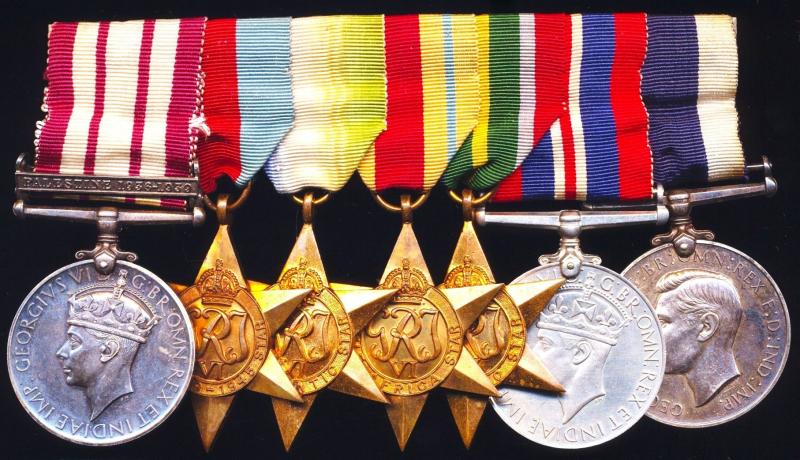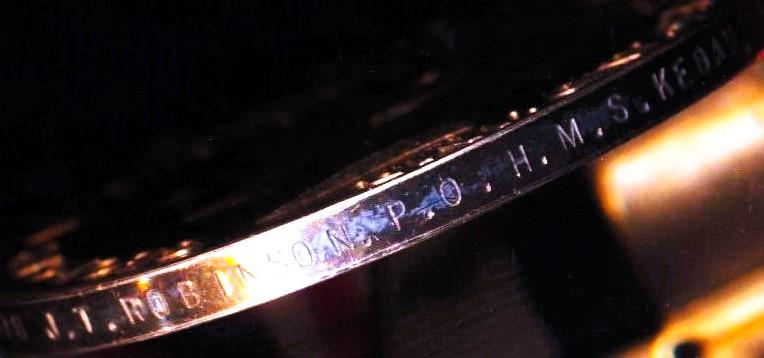The unique requisitioned Straits Steamship Company ship, Palestine, Second World War 'Escape From Singapore' & Naval Long Service group of 7: Petty Officer John Thomas Robinson, Royal Navy late H.M.S. Kedah
- NGSM 1915-62. 'Palestine 1939-36 (JX.127678 J.T. Robinson. P.O. R.N.)
- The 1939-45 Star. No clasp
- The Atlantic Star. No clasp
- The Africa Star. No clasp
- The Pacific Star. No clasp
- War Medal
- Naval LS&GC Medal. GVI first type (JX.127678 J. T. Robinson. P.O. H.M.S. Kedah.)
Unique to Ship Naval Long Service & Good Conduct Medal: The medal is unique named to H.M.S. Kedah - a search of the Admiralty Naval LS&GC medal rolls (ADM 171/141) returns, the medal awarded to Petty Officer Robinson, in Ceylon Colony in 1942, shows that only one LS&GC medal, was ever issued named to H.M.S. Kedah - the requisitioned former Straits Steamship Company steamer
Medals and clasp verification: The recipients entitlement to the Naval LS&GC is confirmed as entitled per endorsements on the recipients extant Naval Service Sheet (held and accessible at The National Archives) and the respective Admiralty medal roll (ref ADM 171/141) the service sheet showing the medal 'Traced' 9 December 1942. The Naval campaign medal rolls for the pre-war Palestine and Second World War are not yet in the Public Domain, and service sheets for the period 1939-46 do not include details of campaign stars or medals awarded during the conflict.
S.S. Kedah / H.M.S. Kedah: With reference to the website 'Ships Nostalgia' we are in part below quoting the most useful summary of the 'Kedah' written by Roy Muir of Ben Line:
Quote,
First passenger ship of "ZIM". She was built for Straits Steamship Company related to the important British company Blue Funnel Line. She started her regular service between Singapore and Penang (today - George Town) and soon obtained the nickname of "The Little Queen of the Malacca Straits". She was built specially for fast service on short distances (of less then 400 miles), in sheltered waters of the Far East. She was named "Kedah" after the north region of Malaya Peninsula. She sailed in this service for 12 years, and carried passengers, cargo and mail.
With the outbreak of WW II, she joined the British Navy. She underwent some structural changes and became an armed patrol ship. Years 1940-1 she spent patrolling along the northern coasts of Borneo and adjacent islands, and as troop carrier.
She took part in evacuation of Singapore, collected survivors of British Navy ships and she was strafed and bombed from air. On February 14th, 1942, just two days before the fall of Singapore, she sailed to Batavia (Java), with hundreds of refugees. On this voyage she was attacked from the air for three hours, but thanks to the brilliant maneuvering skills of her Master, Capt. J. L. Sinclair, succeeded to avoid direct hit. Although she was not hit directly, but nevertheless the close misses severely shook her engines and her speed fell to 7 knots.
From Batavia she sailed to Colombo with 400 refugees on board. Her engines, with no proper maintenance, failed, and the last stage of the voyage she made in tow. After fast repairs, she returned to active service, and operated until 1945 in the Bay of Bengal. During this year she turned to be the commanding ship in the landing operation on the Malaysian Peninsula. She was one of the first ships entering the liberated port of Singapore, hoisting the pennant of Rear Admiral J.A.V. Morse.
She was ordered to sail to England, and on the way, she was used as accommodation ship in Malta. At the beginning of 1946, she arrived, finally, to Barrow, to the same shipyard she was built 20 years before. Here she was released from the Navy and started to undergo repairs. Nevertheless, it was clear, that the progress of transport, and particularly that of air transport, did not leave any space for "Kedah" to resume her operation by her previous owners.
Service sheets showing some of the recipients pre-war service are extant and accessible at The National Archives
John Thomas Robinson, son of John Richard Robinson (a Hotel Barman) and Wilhelmina Robinson (nee Knox) was a native of Blyth, Northumberland, England, where he was born on, 5 March 1910. John joined the Royal Navy on, 14 August 1926, on which date he was rated as 'Boy II'. Prior to joining the Royal Navy, John had been employed as a 'Miner'
Opinion: The recipient was quite possibly a survivor of 'Force Z' (the destruction and sinkings of H.M.S.Prince of Wales & H.M.S Repulse), and posted to H.M.S. Kedah prior to the ship sailing from Singapore Colony for Ceylon Colony in February 1942
A most desirable Naval group and unique named to H.M.S. Kedah
Condition: About GVF
Code: 24333






